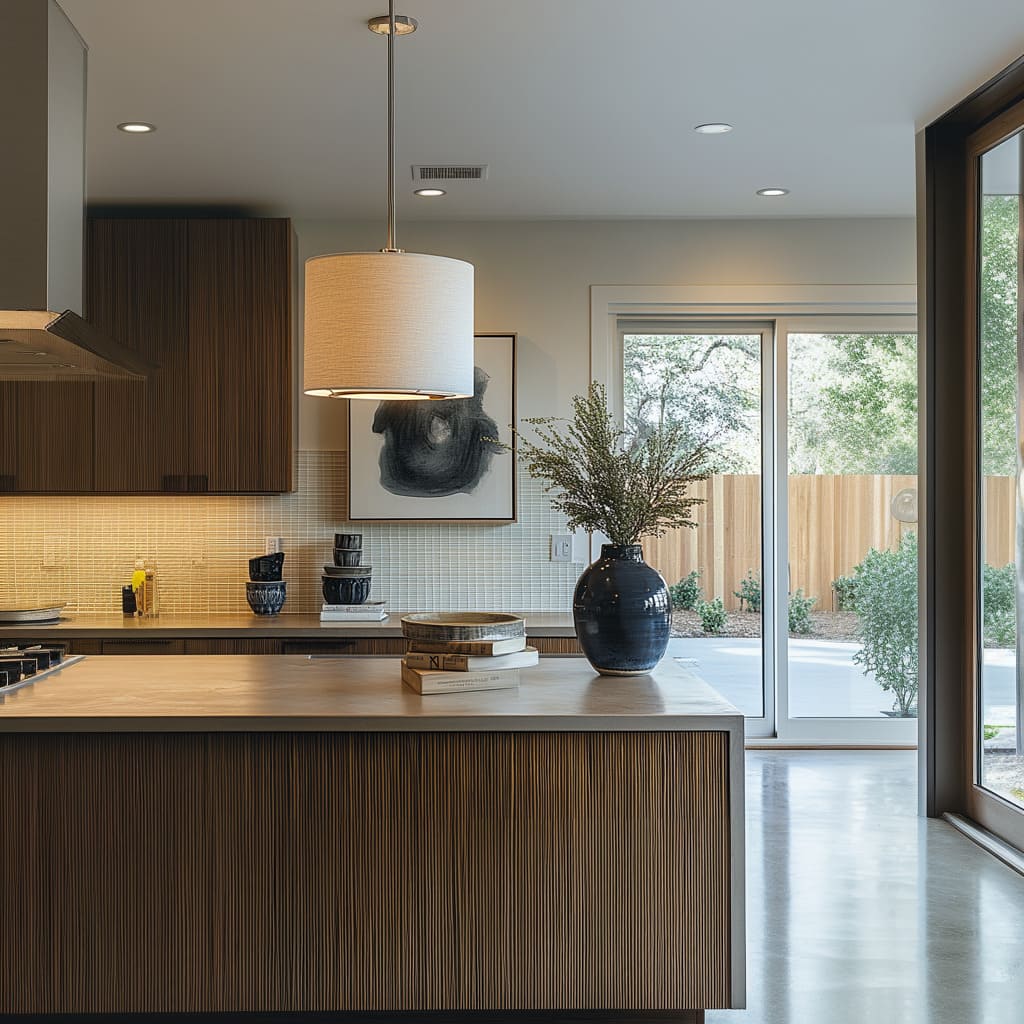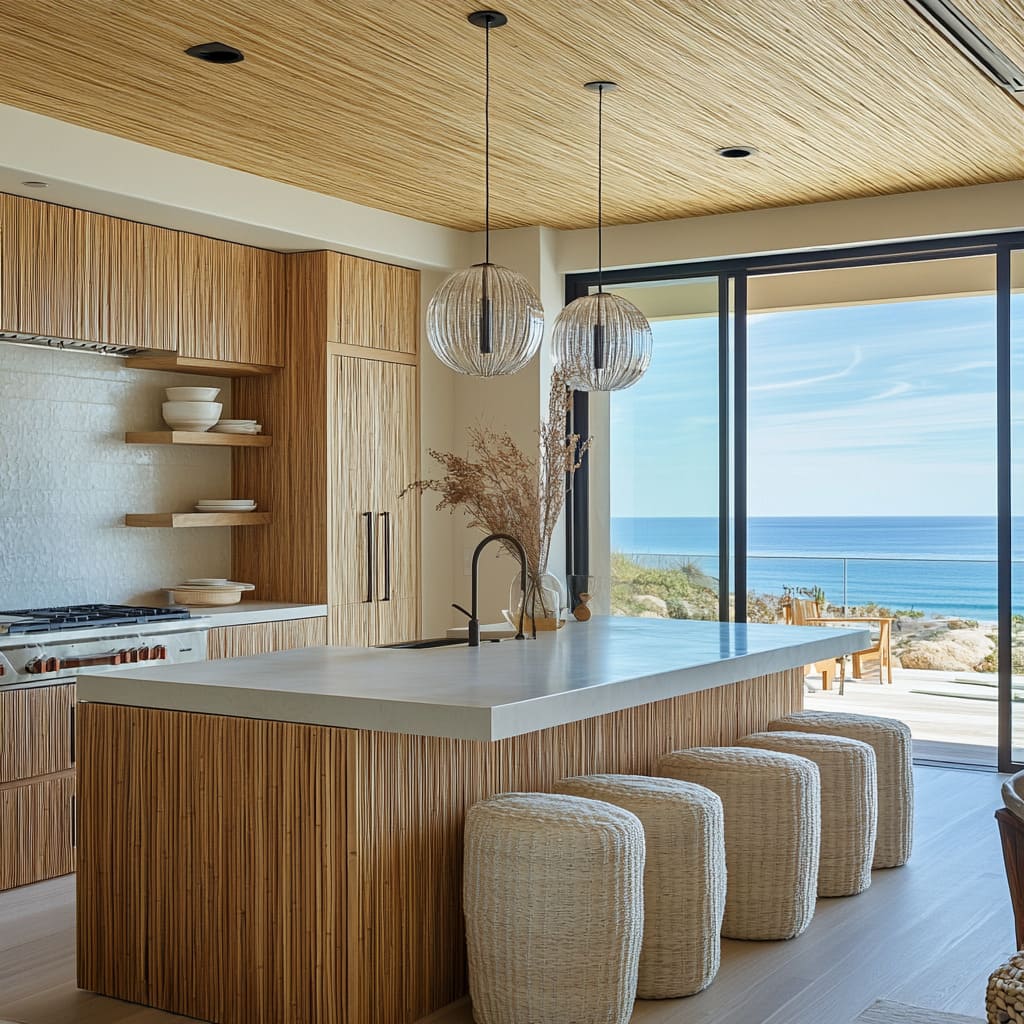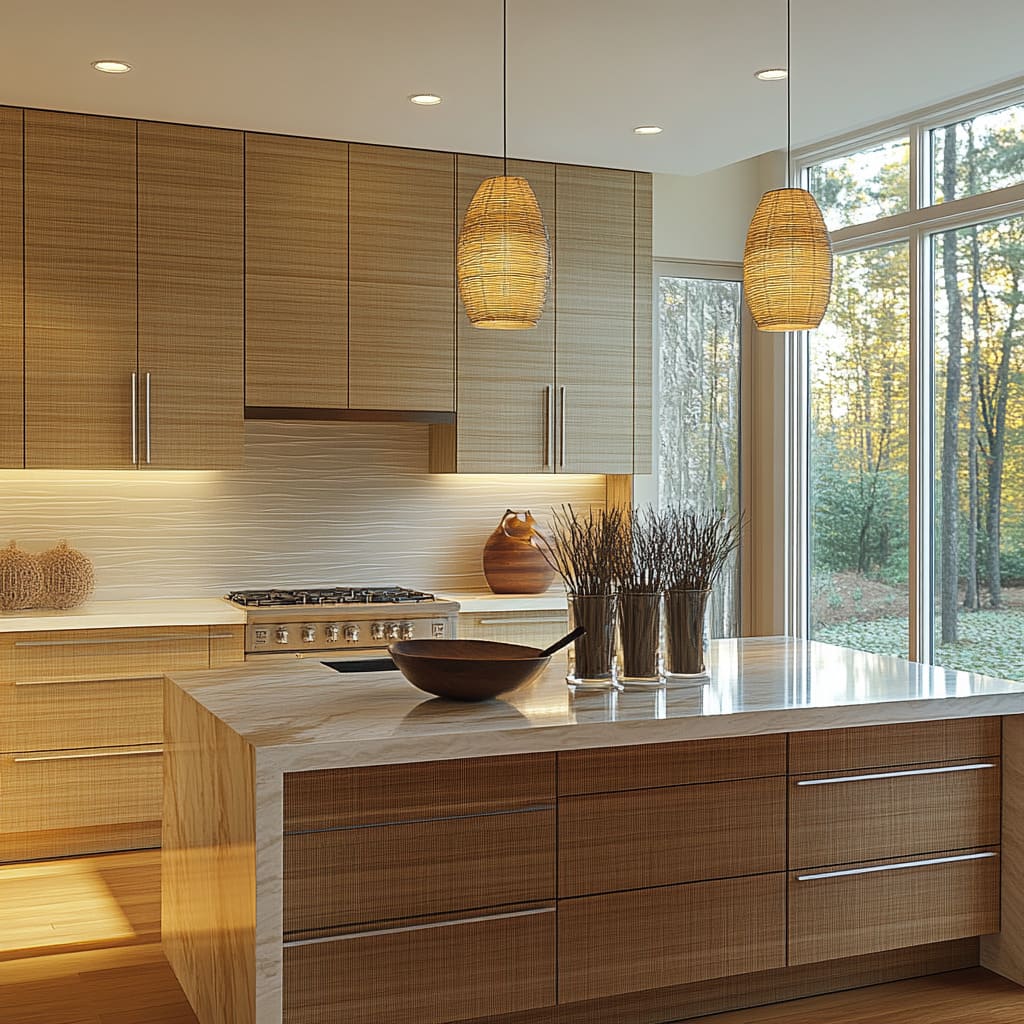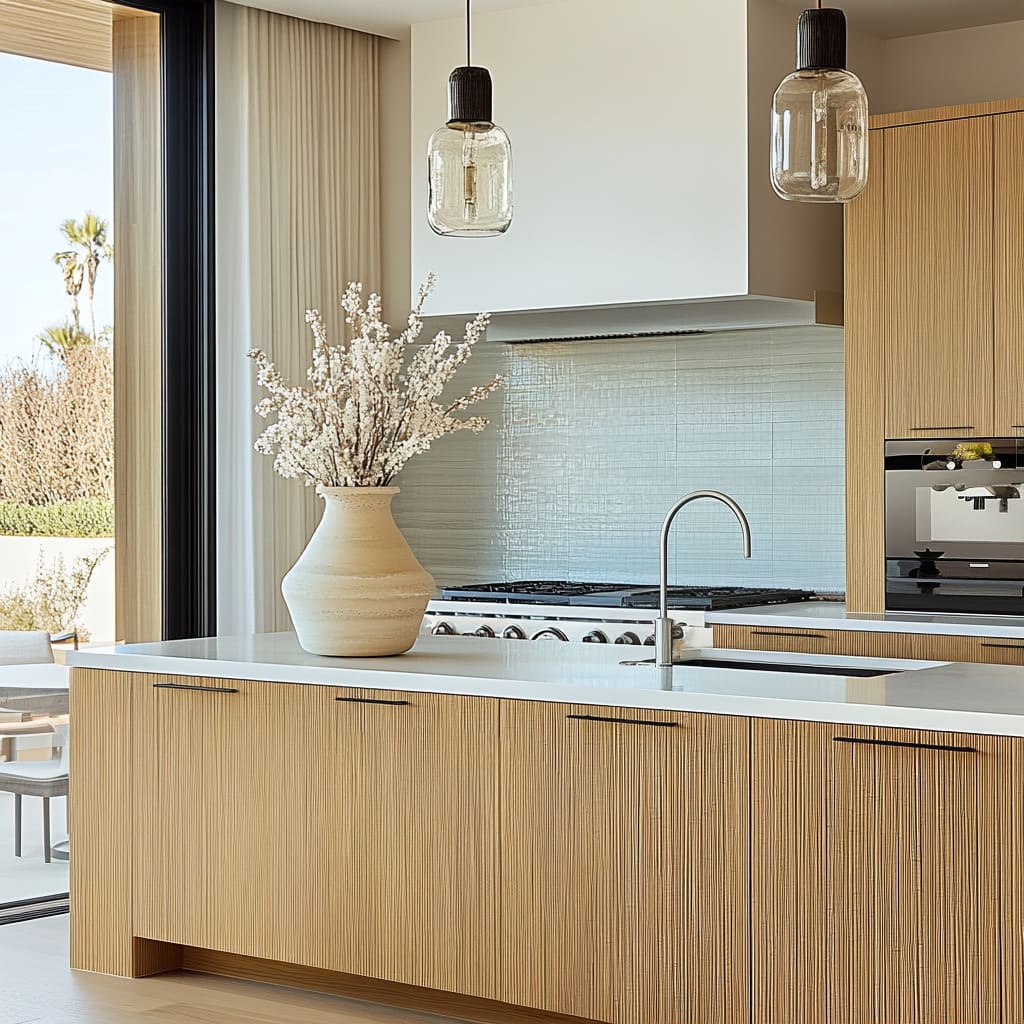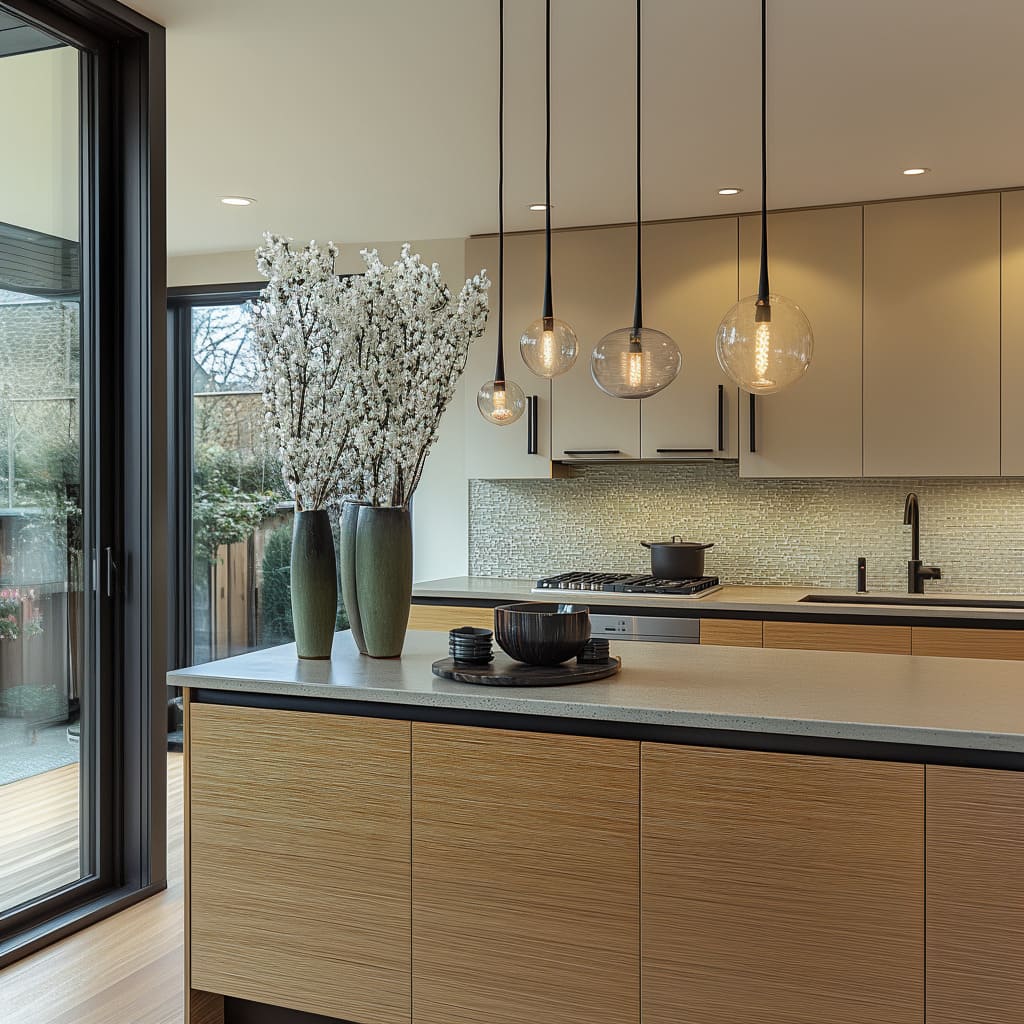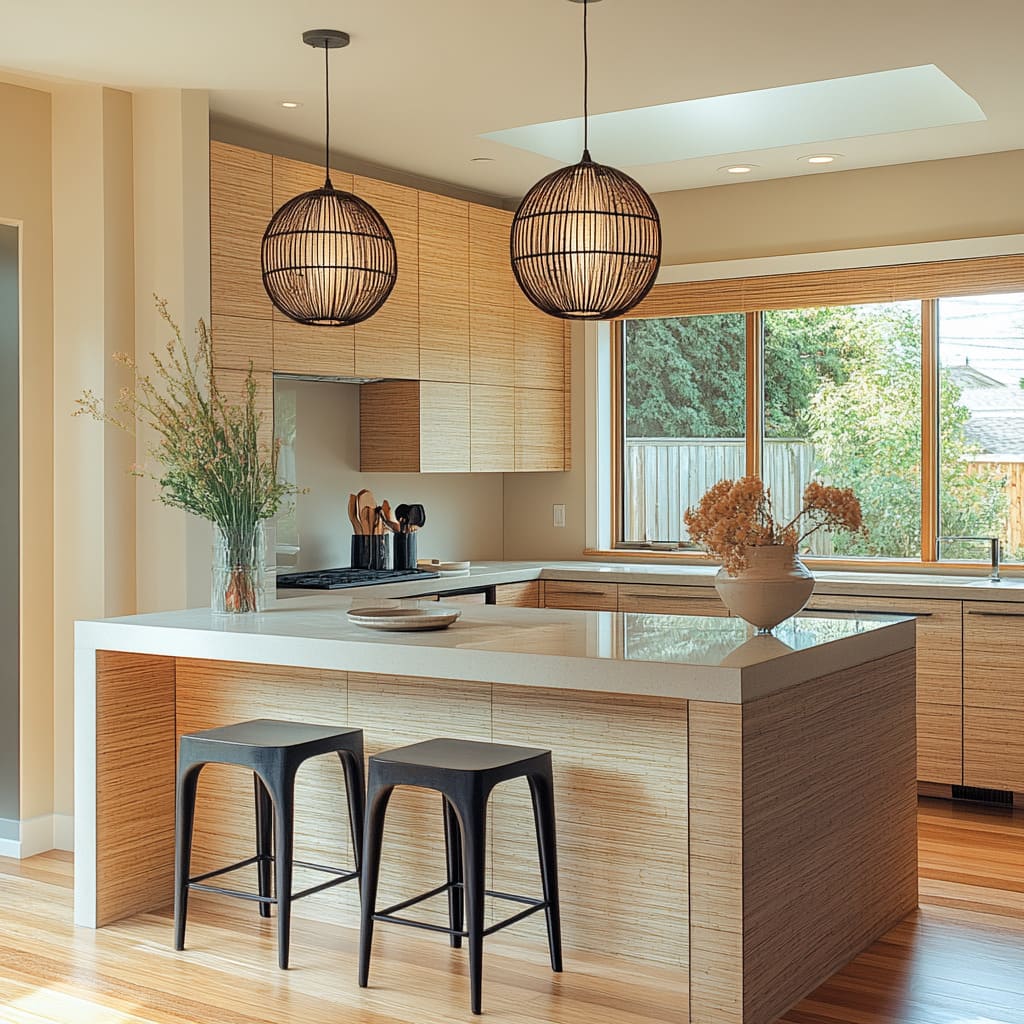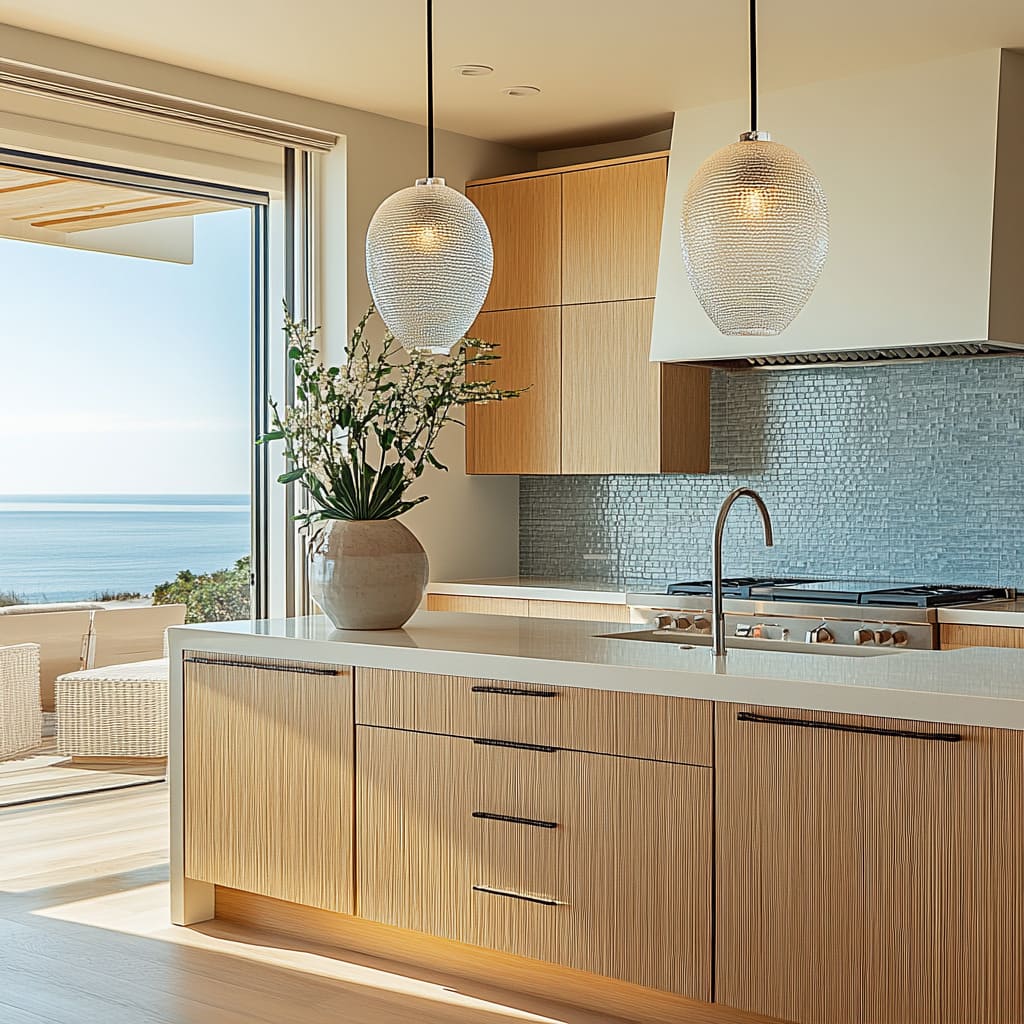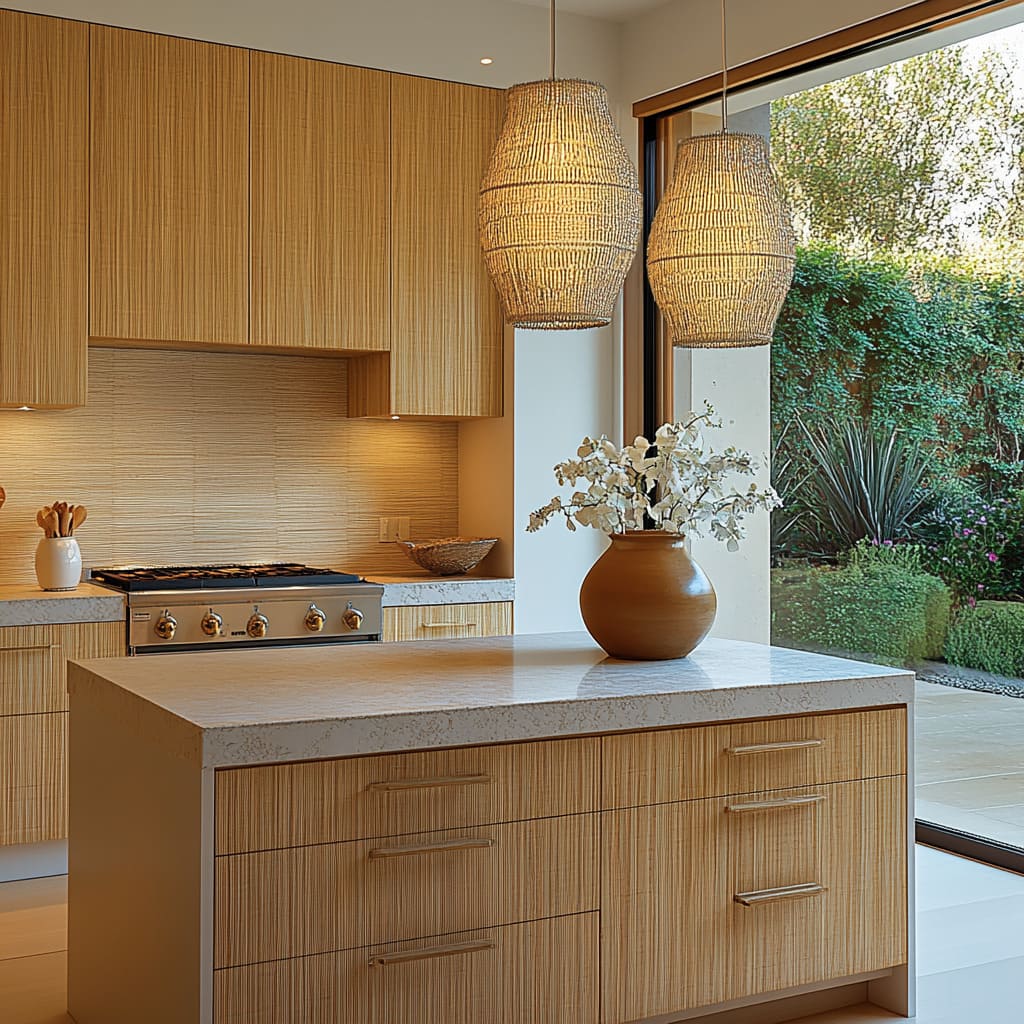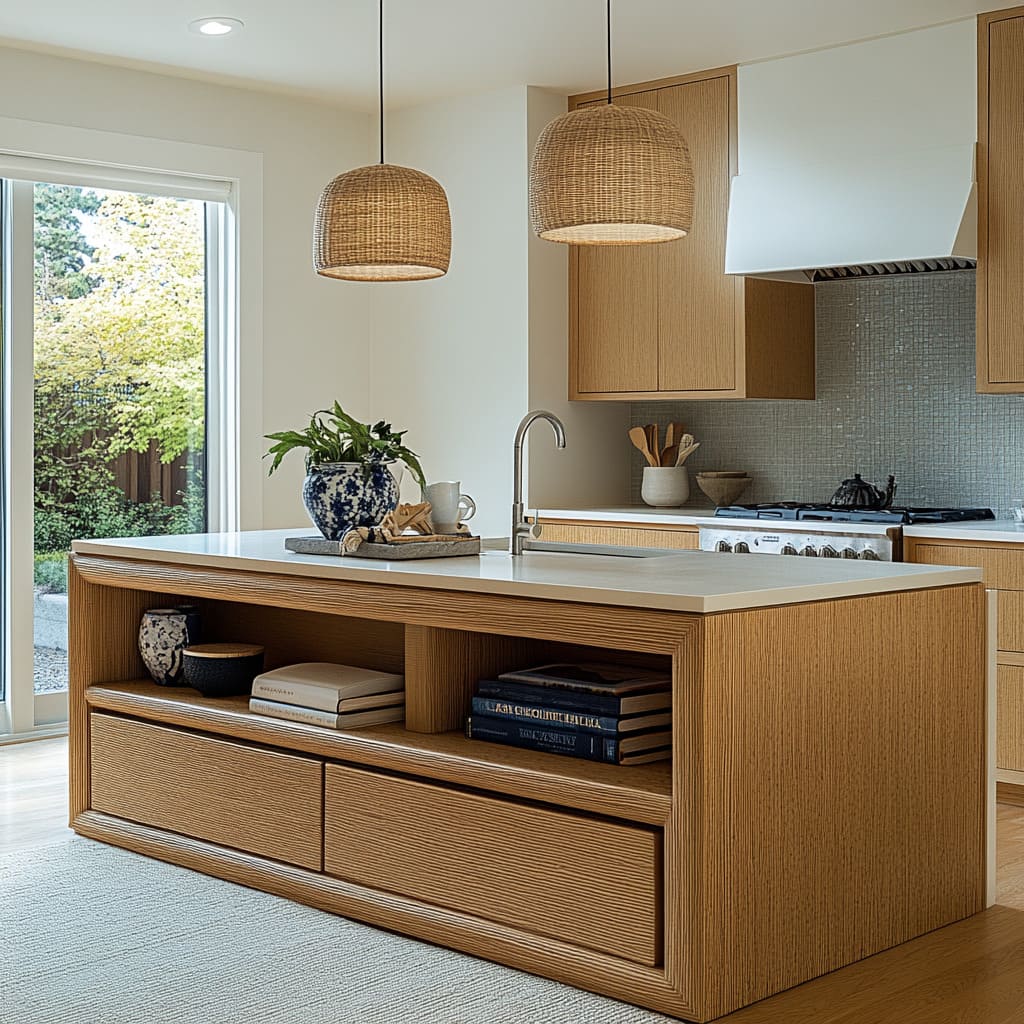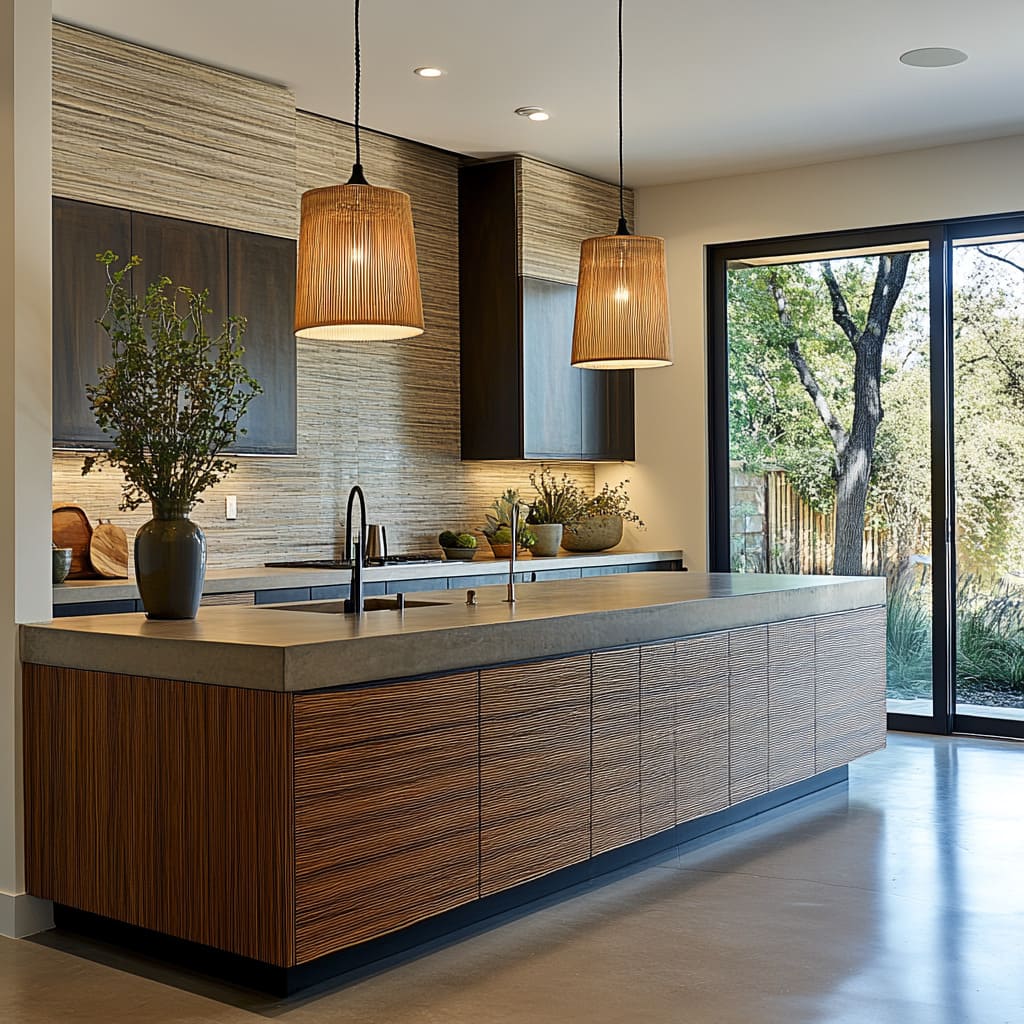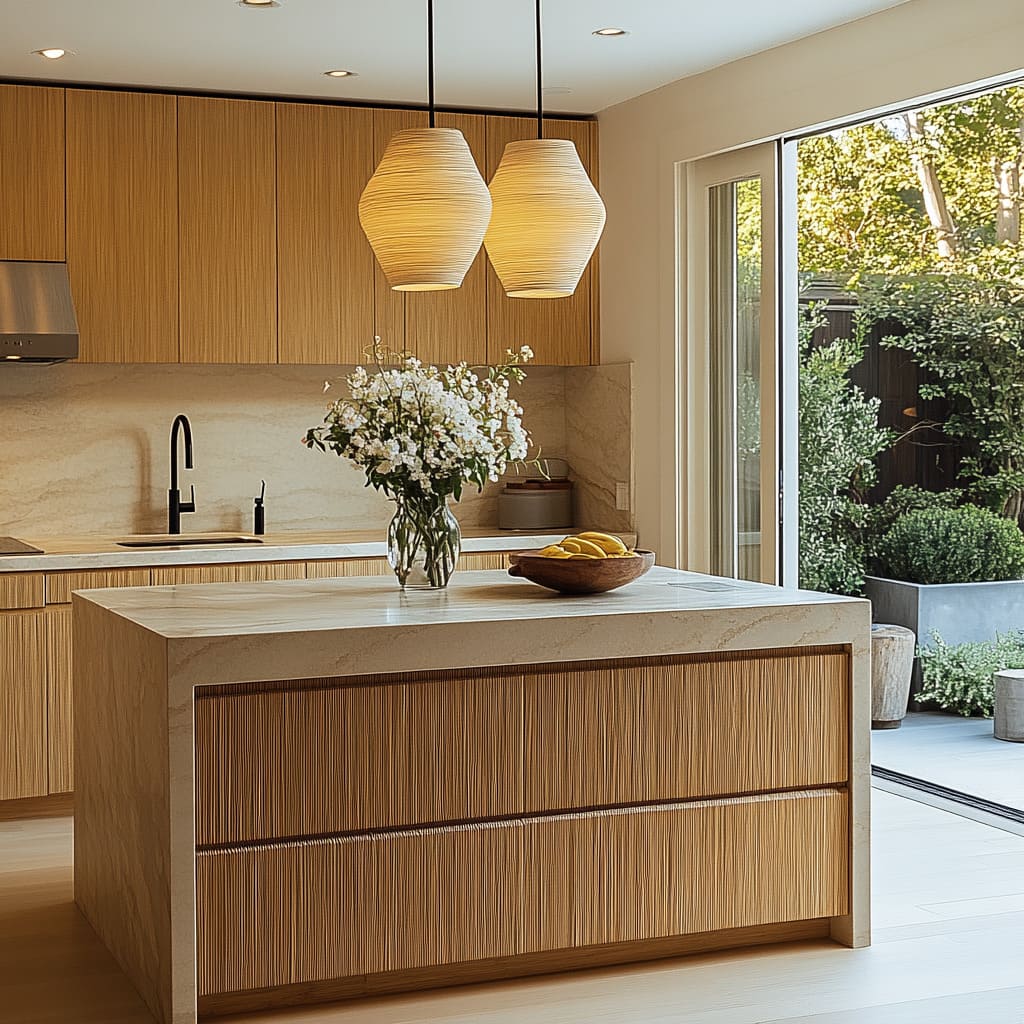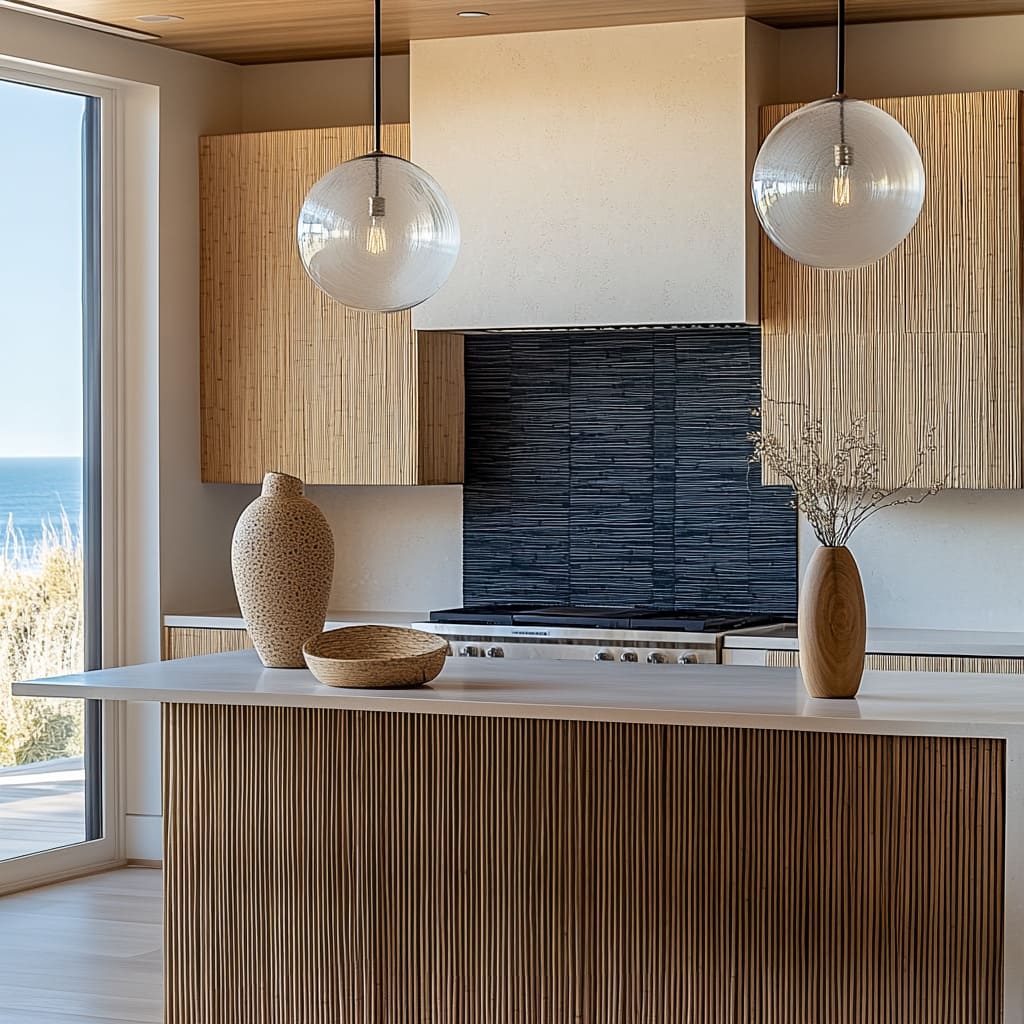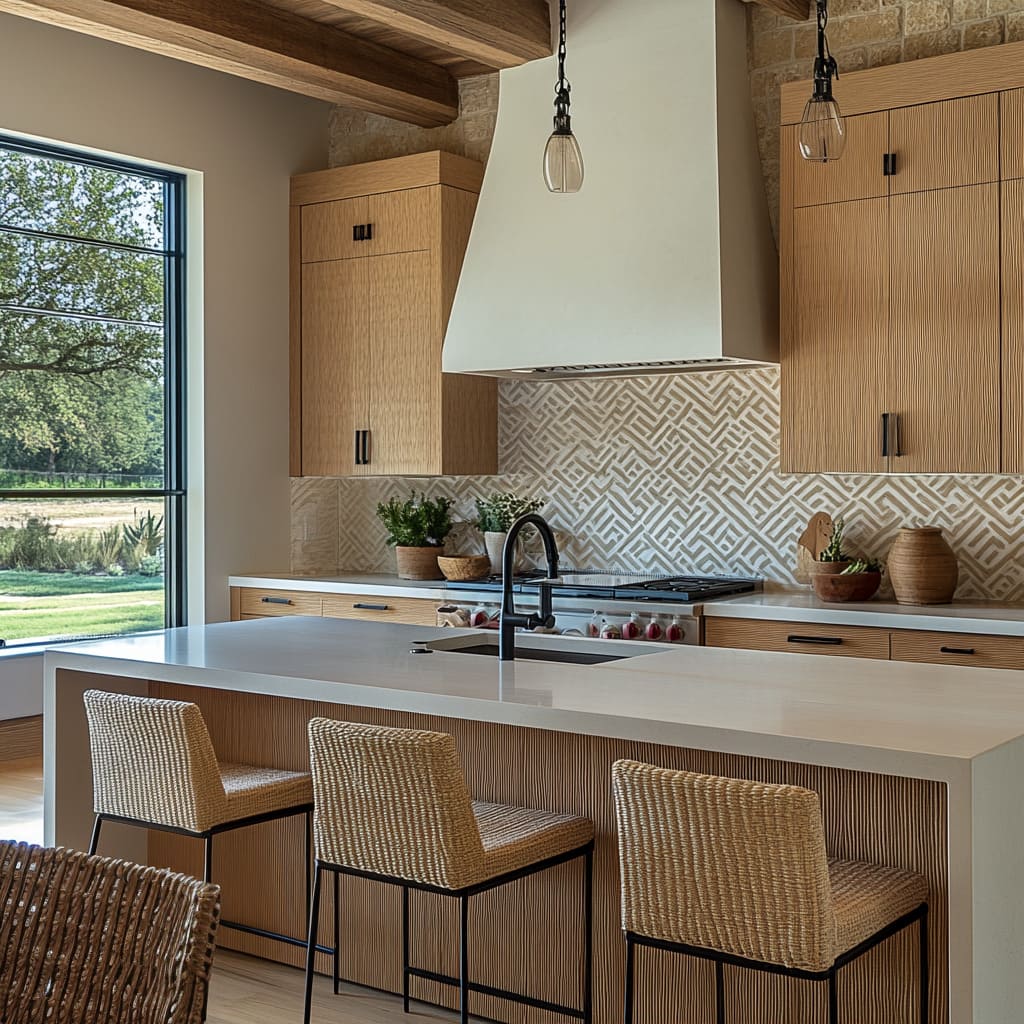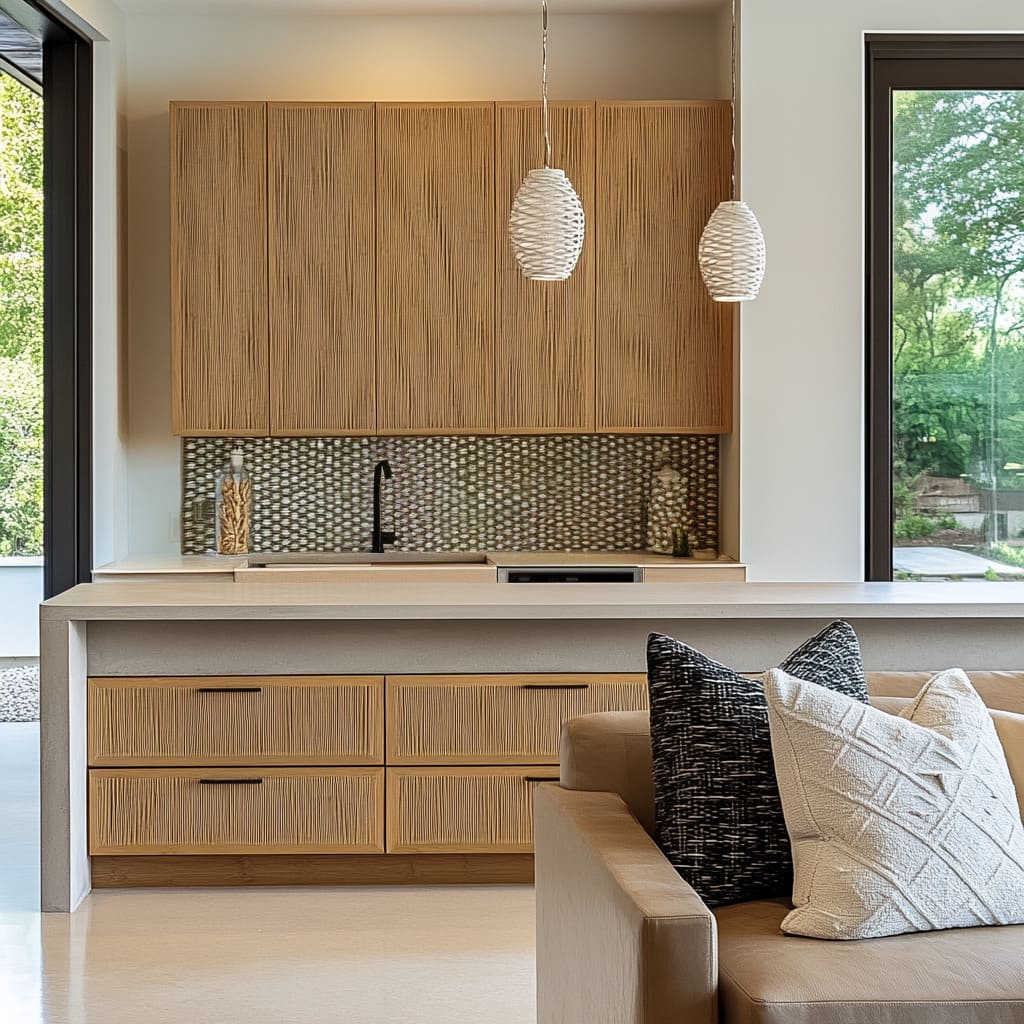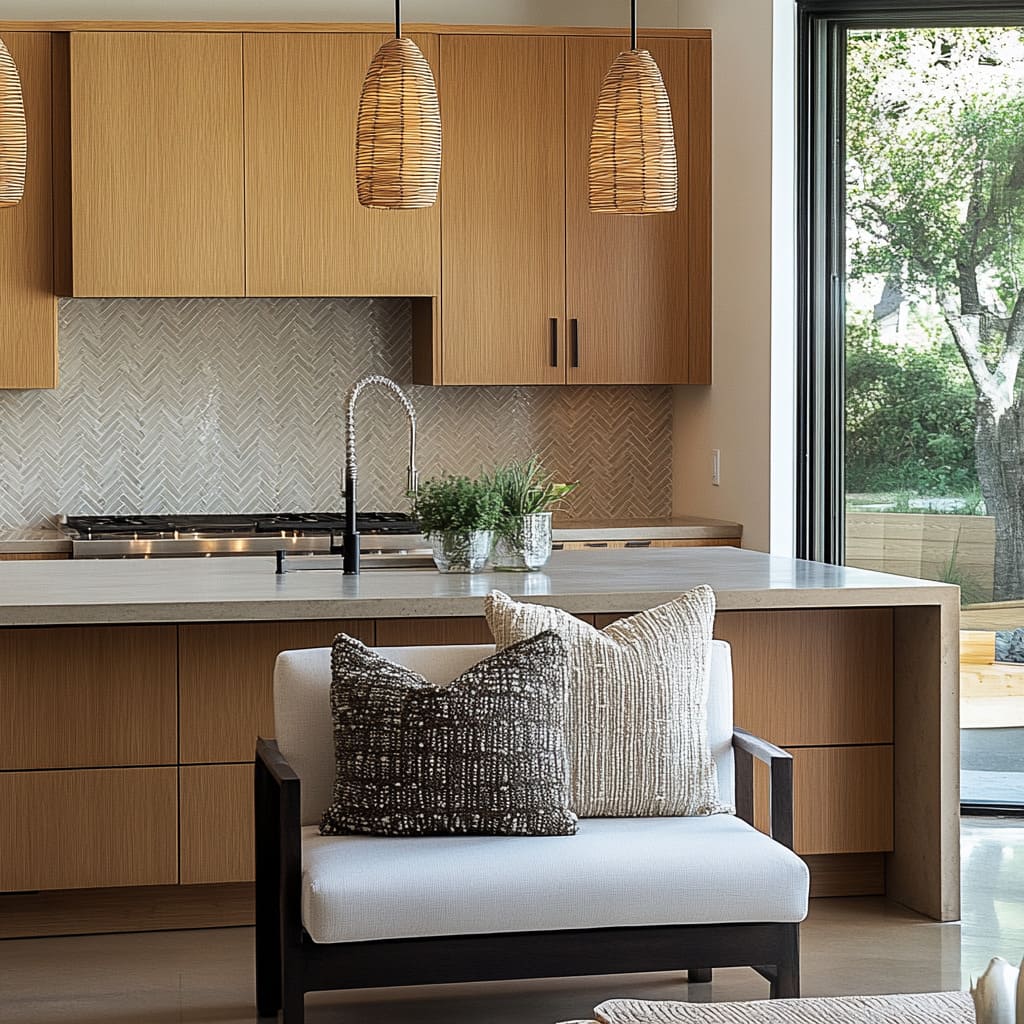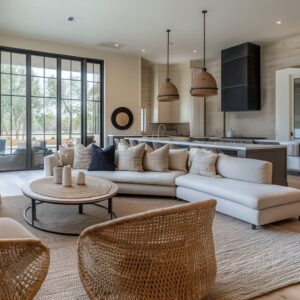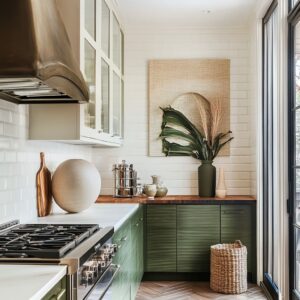Bamboo kitchens are gaining attention for their unique combination of sustainability, versatility, and timeless design appeal. Whether you’re drawn to its eco-friendly nature or its ability to create a warm, inviting atmosphere, bamboo offers a wealth of possibilities for crafting a space that feels both modern and connected to nature.
From sleek cabinetry to textured islands and innovative ceiling applications, bamboo kitchens provide endless inspiration for blending style with function. In this article, we’ll explore practical tips and creative ideas for incorporating bamboo into your kitchen design.
Whether you’re considering bold patterns, subtle accents, or experimenting with natural textures, these insights will help you plan a kitchen that’s not only beautiful but also well-suited to your lifestyle.
Bamboo as a Unifying Design Element
Consistent Grains and Patterns
Bamboo’s natural grain plays a significant role in tying together the overall design of a kitchen. Vertical grain patterns can make a room feel taller by drawing the eye upward, an effect often used in contemporary kitchens to enhance the sense of height.
On the other hand, horizontal grains offer a more stable and grounded look, which is perfect for creating a relaxed and inviting atmosphere.
Color Variations
One of bamboo’s greatest strengths is its versatility in color. Light-toned bamboo is a popular choice for those seeking a bright, open look, often paired with soft hues like white or muted gray countertops.
This combination emphasizes an airy and expansive feel. In contrast, darker bamboo introduces a sense of richness and depth, particularly when balanced with lighter countertops or vibrant accents.
Textural Contrast
Adding texture through fluted or grooved bamboo panels is a clever way to bring depth and personality to a kitchen. This technique is frequently used on cabinet fronts or kitchen islands, where shadows created by the grooves lend subtle dimension without overwhelming the design.
Smooth bamboo finishes, on the other hand, provide a sleek and streamlined appearance for a more minimalist aesthetic.
Takeaway
When exploring bamboo kitchen ideas, think about how grain direction, texture, and color can influence the overall vibe of your space. Aligning the grain direction between upper and lower cabinets offers a cohesive and harmonious look, while mixing directions creates a more dynamic and playful appearance.
Similarly, combining smooth and textured bamboo panels can strike a balance between simplicity and visual interest, giving your kitchen a design that feels intentional and polished.
Mixing Bamboo with Other Materials
Stone and Concrete
A bamboo kitchen design often shines brightest when paired with complementary materials like stone or concrete. Polished stone countertops introduce a sleek, cool contrast to the organic warmth of bamboo, while concrete surfaces add a subtle industrial touch.
These combinations provide a refined balance, making the space feel modern yet grounded.
Rattan, Wicker, and Textiles
Adding woven textures such as rattan pendant lights, wicker bar stools, or cozy cushions is a perfect way to enhance the natural feel of bamboo. These elements echo the warm tones of the wood but bring variation through intricate patterns and textures.
This layering effect adds depth and a welcoming atmosphere to the overall kitchen design.
Metal Accents
Metal fixtures and accents bring a sharp contrast to bamboo’s softer hues. Matte black or chrome finishes are particularly striking, whether used in faucets, cabinet handles, or range hoods.
Industrial-style pendant lights and black-framed stools provide an edgier touch, creating a harmonious interplay between warmth and sleekness.
Takeaway
The key to achieving a well-balanced bamboo kitchen design lies in combining it with complementary materials. Whether it’s the timeless coolness of stone, the tactile appeal of woven rattan, or the modern edge of metal, each element plays a role in highlighting bamboo’s versatility.
Consider how these materials can work together to create a space that feels both inviting and visually engaging.
Backsplash Innovation
Patterned Tiles
Backsplashes in a kitchen design made of bamboo can introduce an extra layer of visual interest through patterns and textures. Chevron and herringbone layouts are popular choices that subtly echo bamboo’s natural lines, while bold geometric designs or wave patterns add a modern twist.
For those looking to create a standout feature, tiles with intricate shapes or stacked stone effects can draw attention and serve as a focal point.
Color Coordination
The color of the backsplash plays a critical role in setting the mood of the space. Neutral tones like beige, taupe, or pale green create a soft, cohesive look that blends seamlessly with bamboo cabinetry.
For a more striking design, darker options like slate or black tiles offer contrast, making lighter bamboo finishes stand out while adding a touch of drama to the kitchen.
Reflective Surfaces
For those seeking to enhance light and space, glossy or glass mosaic backsplashes can do wonders. These reflective surfaces amplify natural light and add a touch of shimmer, making the kitchen feel brighter and more expansive.
This approach works particularly well with darker bamboo finishes, where the backsplash provides a lighter counterbalance to the richness of the wood.
Takeaway
The right backsplash can transform the look of a kitchen, especially when paired with bamboo elements. Whether you choose to mirror bamboo’s natural lines for a harmonious effect or opt for bold contrasts with unique patterns and colors, the backsplash serves as an essential design element.
Consider how subtle neutrals or striking tiles can enhance the overall flow and personality of your space.
Lighting Choices and Their Effect
Pendant Focal Points
Pendant lights play a vital role in accentuating the design of a kitchen while serving as functional decor. In many cases, woven or rattan pendant lights are positioned above the island, bringing natural textures into the overhead space.
These lights complement bamboo cabinet design, tying the look together with a consistent use of organic materials. Minimalist pendant lights, on the other hand, add a sleek and modern contrast while maintaining focus on the kitchen’s clean lines.
Subtle Undercabinet Lighting
Recessed lighting installed beneath the cabinets offers both practicality and style. It provides task lighting for countertops and enhances the appearance of the backsplash and bamboo grain.
This subtle lighting approach ensures that the kitchen remains visually balanced, avoiding the glare of overpowering fixtures while drawing attention to the wood’s natural textures and tones.
Natural Light Integration
One of the most striking elements of kitchens with bamboo features is the abundant use of natural light. Large windows and sliding glass doors are often incorporated to connect the indoor space with the surrounding environment.
This connection enhances the vibrancy of bamboo surfaces as sunlight interacts with their tones and patterns, creating an inviting, nature-inspired atmosphere.
Takeaway
Layering various lighting styles is key to bringing out the best in your bamboo kitchen. Pendant lights make bold visual statements, undercabinet fixtures ensure practical functionality, and natural light adds an organic charm that celebrates the warmth of bamboo.
Together, these elements create a well-lit, dynamic space that feels balanced and cohesive.
Island and Seating Arrangements
Highlighting the Island
In many bamboo kitchen design ideas, the island serves as the centerpiece of the space. By incorporating unique bamboo textures—like fluted or grooved panels—the island becomes a visual anchor, drawing the eye while contrasting or complementing the perimeter cabinetry.
Fluted bamboo fronts are especially effective, adding depth and shadow that create a subtle, sculptural effect.
Seating Integration
Seating around the island offers an opportunity to blend materials and introduce texture. Woven or upholstered bar stools bring softness and variety to the overall aesthetic, balancing the hard surfaces of bamboo and countertops.
Choosing seating with tones that contrast the bamboo cabinetry can make the stools stand out as intentional design elements, framing the island with a touch of flair.
Open Shelving and Decorative Displays
Some kitchen islands include open shelving, which can extend from the sides or perimeter cabinetry. This feature allows for decorative displays or easy access to everyday items, such as cookbooks or artisanal bowls.
This layered approach not only enhances functionality but also breaks up large expanses of wood, adding a more curated and personal touch to the space.
Takeaway
The kitchen island offers a canvas to showcase distinctive bamboo detailing and thoughtful design choices. Use contrasting bar stools to frame the island while introducing texture or color.
Adding open shelving can further personalize the space, blending practicality with visual interest to create a kitchen that feels uniquely yours.
Ornamentation and Greenery
Ceramics, Vases, and Natural Accents
Kitchens with bamboo elements often use simple decor, such as ceramic bowls, terracotta planters, or textured vases, to enhance the natural warmth of the space. These understated additions provide visual interest without overwhelming the design, making them an ideal complement to bamboo shaker kitchen cabinets.
Their earthy tones and handmade qualities harmonize beautifully with the organic appeal of bamboo.
Greenery as a Unifying Touch
Adding potted plants, branches, or fresh flowers is a perfect way to connect the kitchen to its natural inspiration. These botanical accents bring life and softness to the design, seamlessly aligning with the bamboo’s earthy tones.
When combined with large windows or glass doors that overlook a garden or outdoor greenery, the indoor space feels like a natural extension of the outdoors.
Balancing Negative Space
While decorative elements and plants add charm, keeping the layout uncluttered is essential. Carefully curated items are chosen to provide warmth and personality without crowding the space.
This balance ensures the kitchen maintains its calm, open feel, letting the bamboo details remain the primary focus.
Takeaway
Incorporate a few well-chosen decor pieces, such as ceramics and greenery, to complement bamboo’s natural essence. Thoughtfully placed accents can amplify the warm undertone of bamboo shaker kitchen cabinets while preserving a clean, spacious aesthetic.
The key is restraint—select decor that echoes your palette and enhances the overall style.
Notable Unique Features
Layered and Fluted Bamboo
In many modern kitchens, fluted and layered bamboo surfaces are used to introduce a sense of rhythm and depth. This design approach moves beyond flat-panel cabinetry, offering a more sculptural and dynamic look.
Fluting, in particular, adds a play of light and shadow that can make your kitchen bamboo design feel artistic and refined, while still maintaining a natural aesthetic.
Contrasting Dark Bamboo
Dark bamboo finishes, such as rich chocolate or espresso tones, lend a sophisticated and dramatic vibe to a kitchen. These deeper hues work best when paired with lighter countertops, backsplashes, or floors to create contrast and prevent the room from feeling overly heavy.
Thoughtful lighting placement can further enhance the warmth of darker bamboo, ensuring it remains a key design feature.
Bamboo on Ceilings
Some designs extend bamboo beyond cabinetry, incorporating slatted bamboo ceilings that frame the room in a cohesive, nature-inspired envelope. This bold choice enhances the organic theme while giving the space a distinct architectural character.
A bamboo ceiling is particularly impactful in open layouts, where it can visually tie the entire space together.
Takeaway
Bamboo’s versatility goes beyond cabinet fronts. Experiment with innovative uses, like fluted accents, dark finishes, or ceiling applications, to create a kitchen that feels unique and purposeful.
Pair darker bamboo with light, reflective surfaces and ample lighting to maintain an inviting balance, and consider expanding bamboo to walls or ceilings for a more immersive design.
Practical Considerations for Bamboo Kitchens
Sustainability and Durability
Bamboo has earned its reputation as an eco-friendly choice due to its fast-growing nature and renewable qualities. In addition to its sustainability, bamboo is surprisingly resilient when treated properly.
To ensure your kitchen surfaces stand up to daily use, it’s essential to invest in high-quality finishes and sealants. These treatments are particularly important for areas exposed to heat, moisture, or food spills, as they help maintain bamboo’s integrity over time.
Maintenance and Cleaning
Keeping bamboo in excellent condition requires simple but consistent care. Proper sealing not only resists stains but also helps prevent water damage.
Cleaning should involve mild, non-abrasive products to avoid wearing down the protective layer. Be sure to promptly dry any spills to protect the material.
Over time, minor refinishing can help restore the natural shine of bamboo, keeping it looking fresh and vibrant even with regular use.
Cost and Customization
Bamboo offers flexibility in terms of style and application, with options ranging from solid bamboo to veneers in various grains and finishes. The cost will depend on factors like the quality of the material, the thickness of planks, and the level of customization required for your kitchen design.
Whether you’re seeking a minimalist look or intricate detailing, bamboo provides a range of possibilities to suit different budgets.
Takeaway
When designing a bamboo kitchen, prioritize high-quality materials and protective treatments to ensure the surfaces can handle everyday demands. With the right care and attention, bamboo will retain its natural charm and durability, making it a practical yet stylish choice for your home.
Final Thoughts
Bamboo kitchens can range from airy and coastal to dramatic and modern, depending on finish, color scheme, and accompanying materials. By weaving together natural textures, thoughtful lighting, and balanced ornamentation, you can shape a cooking space that feels both distinctive and comforting.
Consider how grain direction, the addition of greenery, and complementary surfaces (stone, concrete, rattan, etc. ) might amplify or soften the look.
With attention to sealing and upkeep, bamboo can stand the test of time and provide a warm, inviting backdrop for everyday living.
Use these observations as a starting point for your own kitchen layout. Look for ways to emphasize or contrast bamboo’s inherent warmth, integrate unique textural elements, and coordinate your color palette to create a visually engaging yet functional space.
